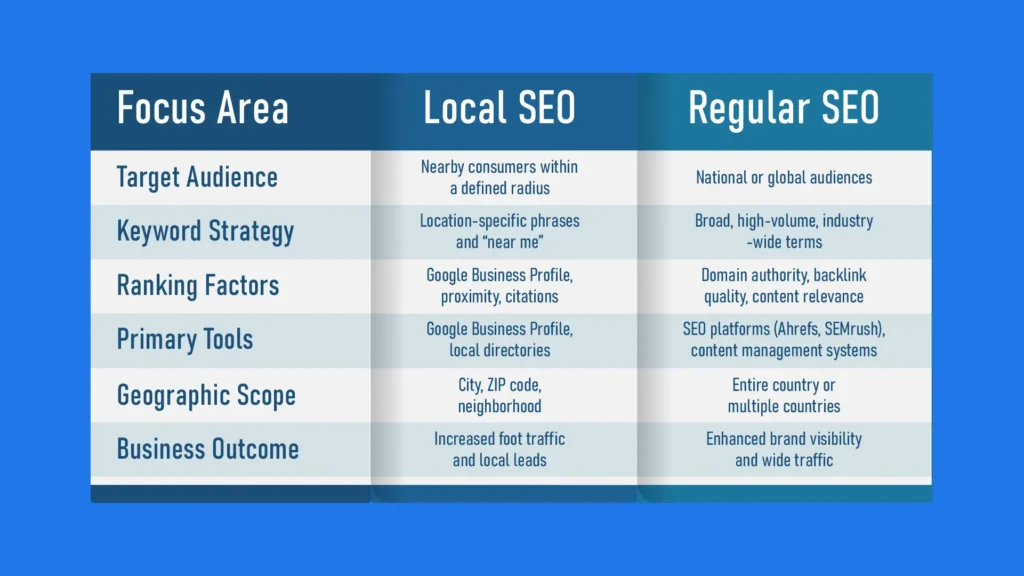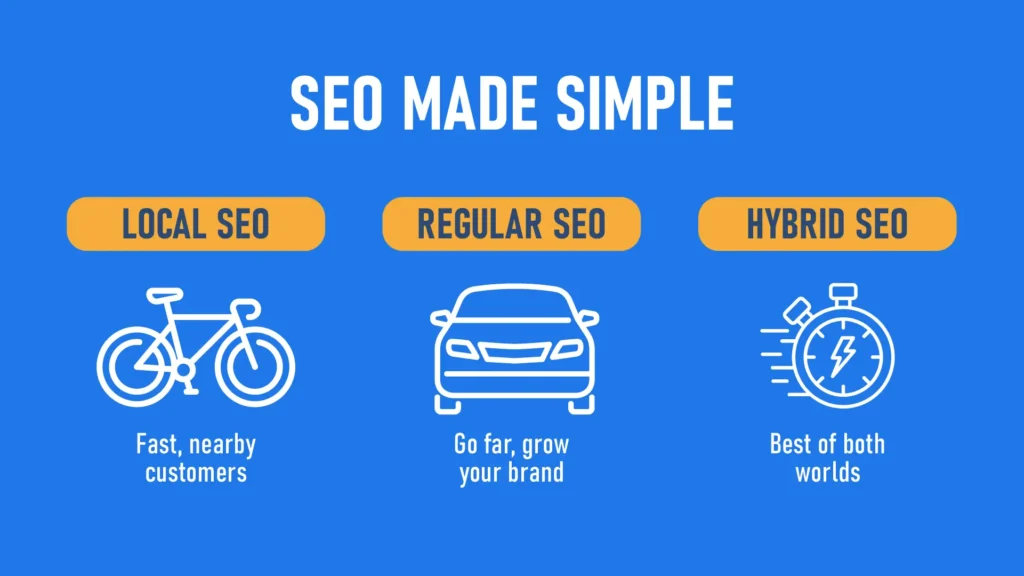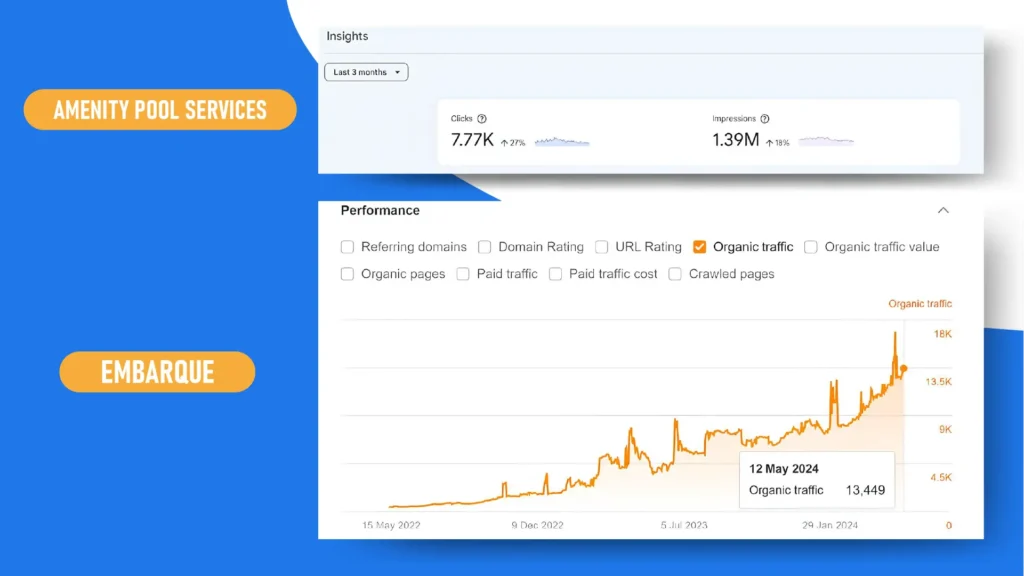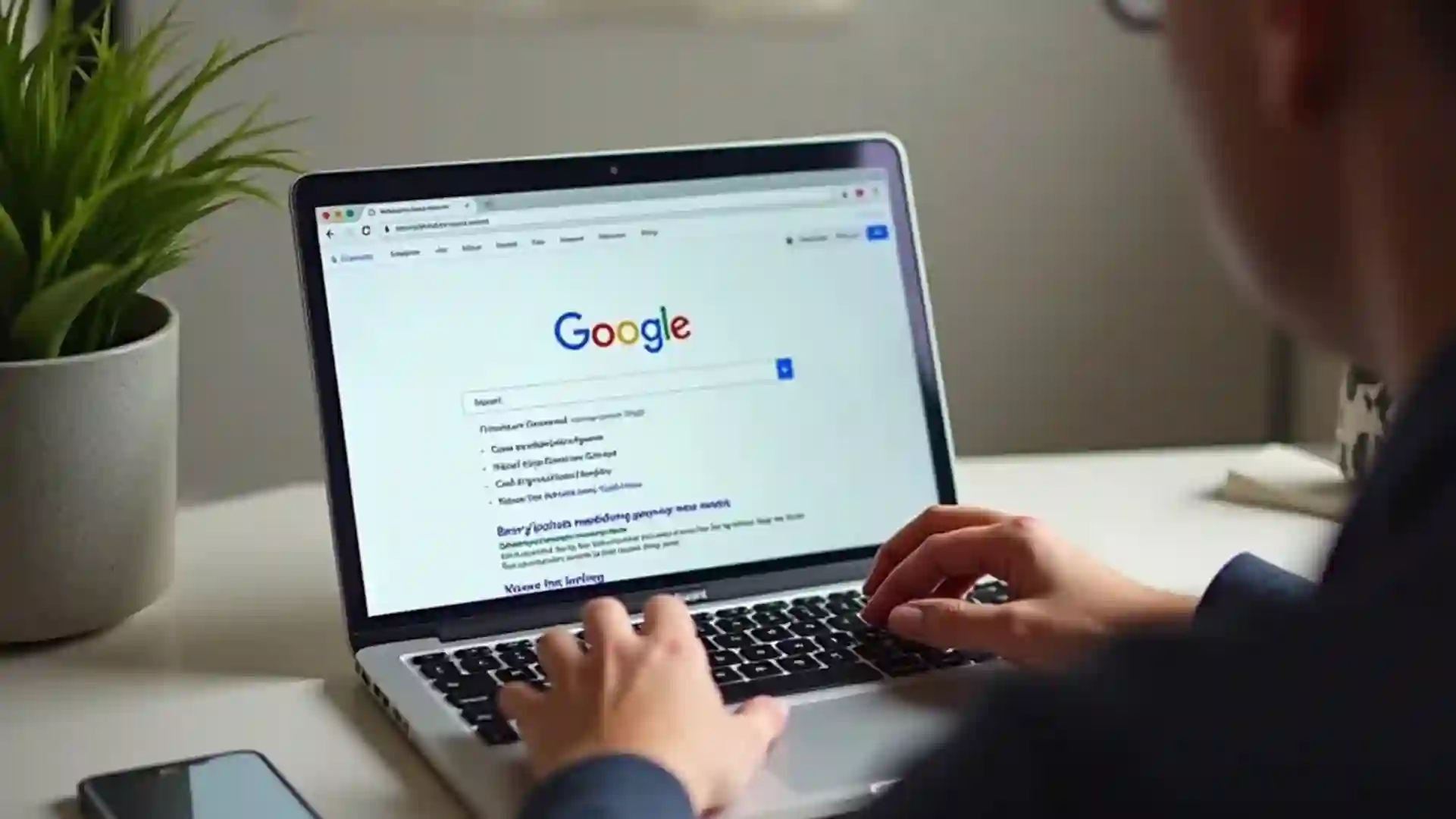When people talk about SEO (Search engine optimization), they often mean strategies designed to help websites rank broadly across search engines. But there’s a key distinction: some businesses need visibility everywhere, while others only need to be found in their own city or region. That’s where the difference between local SEO vs SEO comes in. In fact, nearly half of all Google searches have local intent, meaning users are looking for products or services nearby.
In this article, we’ll break down what each approach really means, the ranking factors that matter most, and how businesses can decide whether to focus on local, national, or even a mix of both.
What Is Regular SEO and How Does It Work?
Traditional or global SEO is all about beating the competition for those local search terms that matter, it’s all about how well your content matches up, how wide-ranging it is, how solid your site’s tech is, and how strong it is.
Regular SEO is all about targeting big industry terms instead of just local stuff, so it gets businesses ready to jump into national or even global markets and grow without spending much.
So, if you’re just getting the hang of SEO, we’ll break down the main ideas in the next part.
Which Ranking Factors Influence Regular SEO Success?
Regular SEO success depends on a mix that matters to users and solid tech skills:
- Content Quality Entities: These in-depth guides and top-notch articles really boost the time people spend on the site and how often they click on stuff, which is awesome for getting more traffic and engagement.
- Backlink Profile Entities: Editorial links and guest posts are worth it because they boost your site’s domain authority.
- Technical SEO Entities: Site speed, structured markup → Value: enhanced crawlability and user experience..
- User Experience Signals Entities: Lower bounce rate and better mobile usability = more engaged users .
These things go hand in hand to make your site pop up more in searches, and getting the hang of them naturally leads to knowing the local game for customers close by.
What is Organic & Local SEO Based On?

Local SEO is optimization tailored to geographic intent, helping businesses appear prominently in local search results, Maps listings, and the Local Pack. By focusing on proximity, relevance, and prominence signals, Local SEO drives nearby customers to bricks-and-mortar locations or service-area businesses. For a comparative perspective on global versus local targeting, refer to Local SEO vs Global SEO- What’s the Difference?
What Are the Primary Goals of Local SEO?
- Boost visibility on Google Maps and in the Local Pack.
- Generate qualified local leads and in-store visits.
- Enhance proximity-based relevance for on-the-go searchers.
By accomplishing these goals, businesses capture high-intent consumers within their service areas. Let’s break down the essential elements that power this process.
Which Key Elements Make Up Local SEO?
- Google Business Profile optimization with accurate NAP details.
- Consistent citations across directories and industry platforms.
- Soliciting and managing positive customer reviews.
- Incorporating location-specific keywords in content and metadata.
- Implementing local structured data to highlight address and operating hours.
Every item solidifies trust indicators and aid search engines validate local relevancy resulting to better location intent recognition.
Local SEO VS Regular SEO
Local SEO and regular SEO diverge in audience focus, keyword strategy, ranking determinants, tools, geographic scope, and expected outcomes. The table below outlines these contrasts with clear attributes and values.

Focusing on “near me” modifiers and city names drives local relevance, while broader terms build authority at scale.
What Are the Differences in Target Audiences for Local SEO vs SEO?
Local SEO targets those with ready-to-buy intent who are near the business and thus is more precise than normal SEO, which targets anyone researching a product or service online even if they have no geographical context. Content and platform choices are based on audience proximity for each approach.
How Are Local SEO Keyword Strategies Different Than in Regular SEO?
Local SEO focuses on “service + city” or “near me” hybrids to align page and map results, while traditional SEO covers broader head terms and long-tail derivatives to serve multiple search intents in regions. This difference actually affects content planning and metadata optimization.
What Are the Unique Ranking Factors for Each Type of SEO?
- Proximity
- Google Business
- Google local pack
- Profile accuracy
- NAP consistency
- Review volume
These are where local SEO gets its juice. Traditional SEO relies on the authority of a domain, quality backlinks, being topical and relevant (up to date), and great technical structure. Each set of factors provides information on tactics.
What Should You Use for Local and Regular SEO?
Local SEO tools you should use Tools like Google Business Profile dashboard, BrightLocal, Local Falcon for citation auditing and review management. Typical SEO utilizes SEMrush Ahrefs Moz to research keywords, competiting analysis, and backlink tracking.
When Should Businesses Choose Local SEO, Regular SEO, or a Hybrid Approach?

Think of SEO like choosing the right vehicle. Do you need a bicycle to zip around your neighborhood, a car to travel across the country, or a hybrid ride that can do both? Your choice depends on where your customers are, how far you want to go, and how big your growth plans are.
- Local SEO is your bicycle: fast, efficient, and perfect for converting people right around the corner.
- Regular SEO is your car: built for the long road, expanding your reach and brand authority across wider markets.
- Hybrid SEO? That’s your electric hybrid, giving you the best of both worlds with local visibility and national traction.
What Business Scenarios Favor Local-First SEO?
Local SEO shines when your business thrives on community connections. Picture it as the digital version of a friendly “Open” sign on your shop window:
- A boutique shop luring in weekend foot traffic.
- A plumber racing across town to fix a leak.
- A medical clinic welcoming patients who search “near me.”
Here, your marketing dollars go straight into meeting nearby demand through your web page and local search.
When Is National or Organic SEO More Effective?
Now imagine your business with no borders. You’re not waiting for someone to walk past your storefront; you’re sending your product or service out into the world. National SEO works best when:
- You run an e-commerce store that ships everywhere.
- You have a specific product on a landing page
- Your SaaS product powers businesses in multiple countries.
- You publish content meant for mass audiences, not just your zip code.
This strategy amplifies your voice far beyond the local chatter, turning reach into recognition and increasing your reputation.
How Can a Hybrid SEO Strategy Maximize Visibility and Growth?
The smartest brands don’t choose, they mix. A hybrid strategy blends the immediacy of local SEO with the scale of regular SEO. Imagine running both a community farmer’s market booth and an online store that delivers nationwide:
- Your Google Business Profile pulls in walk-ins from down the street.
- Your blog posts rank for high-value national keywords.
- Your web page is ranking in the region
- Your backlink profile includes both local mentions and authoritative industry sites.
With this approach, you keep the local leads flowing while also planting seeds for national growth.
What Cost Advantages Does SEO offer?
Traditional ads such as TV commercials, radio spots, or billboards are like renting space on the busiest street in town. You must keep paying to stay visible, and as soon as the money stops, so does the attention. Both Local SEO and Regular SEO flip the script by creating long-term visibility and cutting down on the cost of getting people to notice you.
Local SEO: Cost-Smart for Community Growth
Think of Local SEO as setting up a bright digital sign that only the right folks (and ready to buy) can spot.
- Targets high-intent searches: (“plumber near me”) that convert faster and cost less.
- Google Business Profile: Reviews, and citations are always on, no need to keep spending money on them. Your rep and rankings keep climbing, even when you hit pause on campaigns.
If Local SEO is your standout sign, Regular SEO is like your big voice, shouting your brand all over the internet big time.
- Content compounds: A well- optimized article and web page can pull traffic for years.
- Wider markets = bigger payoff: Awesome for online shops, software services, and news sites looking to expand their reach beyond just one city.
- Lower long-term CPC: Paid ads keep costing you per click, but once you’ve put in the effort, organic traffic is free and keeps on giving.
Local SEO tips = save money by targeting nearby customers who are ready to buy.
Regular SEO = long- Getting a better ROI, reaching bigger audiences without endless advertising spend.
Real-World Examples of Local SEO vs. Regular SEO Success

Local SEO Success Story: Amenity Pool Services
Amenity Pool Services wanted more people in their community to find them when searching for pool cleaning and maintenance. Over the past three months, MoreKeting helped them shine online by optimizing blog content, refining local keywords, and improving their Google Business Profile.
The results were impressive. Clicks went up by 7,770, a 27 percent increase in user interactions. Impressions jumped by 1.39 million, meaning far more people were seeing their content. Blog posts like “Can You Swim While It’s Raining” and “3 Reasons You Might Feel Sick After Swimming” saw traffic explode, with increases of over 300 percent to 600 percent.
Most exciting of all, Amenity Pool Services climbed from position 40 to position 11 on key local search queries. That is a huge leap toward page one, making it much easier for homeowners to find them when they need pool services. This story shows how local SEO can turn a neighborhood business into the go-to choice in its area.
Global SEO Success: Instatus
Instatus, a SaaS company in the status page industry, had zero SEO. With Embarque, they prioritized content on DevOps, incident management and monitoring, going after high-opportunity, low-competition keywords.
The results were staggering. Organic traffic grew by 1,536%, top positions were maintained for hundreds of keywords, and the Monthly Recurring Revenue increased 833% in less than a year.
This proves that with the correct SEO strategy, a global brand can also grow quickly, capture the right audience and convert clicks into real business.
FAQ’s
Local SEO is about improving search visibility for businesses in a particular city or region, to target them with local search made by customers and boost their reputation. It gives priority to Google Business Profiles, proximity and citations to generate nearby footfalls, relying on local search terms. The typical SEO marketing, in contrast, works to make you more visible for organic search all over the country and build your brand authority with a larger target audience.
Local SEO makes sure that your business is visible in Google search for queries with local intent, such as “plumber near me” or “coffee shop in [city]. By optimizing for local search and keeping all of your information uniform across directories, you can maintain a high position on search engine results page listings and getting your business in front of the right people without depending solely on paid advertising.
It really varies based on your goals and target audience. If you depend on local patrons, local SEO is the way to go so that you can show up in the search engine results page (SERPs) and Local Pack for a purchase decision. And if you’re serving a more general market and have a content marketing strategy for brand awareness, SEO will help get your brand seen through Google search. A hybrid strategy that includes local optimization and broader marketing tactics to funnel leads and traffic.






